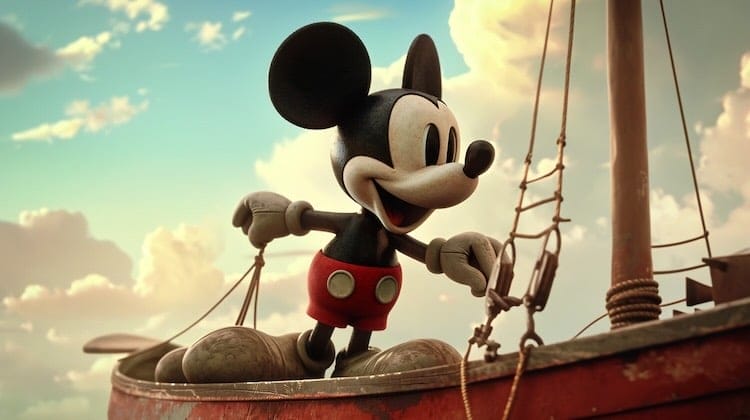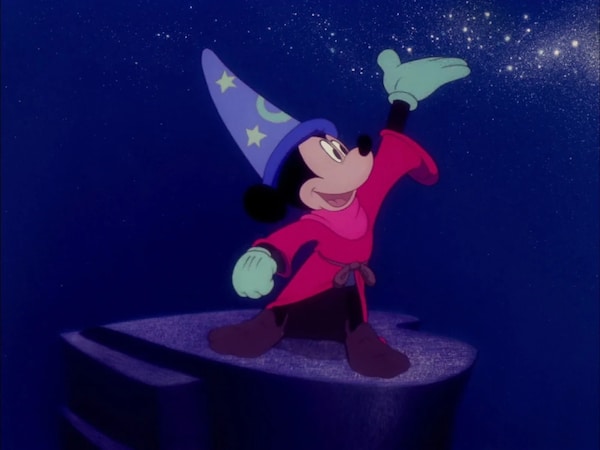(UPDATED) When the Copyright Act was first enacted in the United States, the duration only lasted 14 years. Today, copyright duration can last over a century. Why such a drastic change? Some say it is all due to the power and influence of the Walt Disney Company and its desire to maintain the Disney copyright of a cute mouse named Mickey.
However, with Steamboat Willie, the animated short film that introduced Mickey Mouse to the world in 1928, losing its copyright and entering the public domain, some say that the myth has officially ended. But has it? How much influence did Disney have on changing copyright duration, and what might happen when later versions of Mickey Micky Mouse are about to lose copyright protection?
Copyright Revision Timeline
Disney’s copyright for Mickey Mouse is a saga spanning nearly a century. Since his first appearance in Steamboat Willie, Mickey Mouse has evolved into a symbol recognized around the world. For Disney, Mickey is more than a character; he is the cornerstone of their brand, so maintaining control over how people use Mickey Mouse is critically important to the Company.
Steamboat Willie (1928)
Disney is also a powerful company that can, through lobbying efforts, make a significant impact on policy that affects its brand. So it is no wonder that when people began to notice that significant shifts in copyright duration coincided with the expiration dates of the Mickey Mouse copyright, Disney’s efforts would be the logical cause.
Yet, copyright duration has been changing since the country’s inception. In the Copyright Act of 1790, copyright protection was only available for maps, charts, and books, so Mickey MNouse wasn’t even eligible for a copyright. Plus, the initial term was only 14 years but was allowed to be renewed for one additional 14 years as long as the author or creator was alive at the end of the first 14 years. Registration with the U.S. Copyright Office and use of a copyright notice (© Company Name (1790)) were also required. If you didn’t register with the U.S. Copyright Office or add the copyright notice to the work, it immediately entered the public domain, so any person or company could use it in any way they wanted without permission from the creator.
In the Copyright Act of 1790, the initial 14-year term was allowed to be renewed for one additional 14-year term as long as the author or creator was alive at the end of the first 14 years. Registration with the U.S. Copyright Office and use of a copyright notice (© Company Name (1790)) were also required. If you didn’t register with the U.S. Copyright Office or add the copyright notice to the work, it immediately entered into the public domain, so any person or company could use it in any way they wanted without permission from the creator. If Mickey Mouse had been created back then, it wouldn’t have been eligible for copyright protections since copyright was only available for maps, charts, and books.
The Copyright Act of 1831 was the first major revision to U.S. Copyright Law, mainly due to lobbying efforts by American lexicographer Noah Webster.. As part of this revision, the copyright duration changed from 14 years to 28 years, with an option to renew the copyright for another 14 years. Additionally, Copyright protection became available for musical compositions (though this protection only extended to reproductions of compositions in printed form; the public performance right was not recognized until later).
The Copyright Act of 1909 was the next major overhaul of copyright protection, signed into law by President Theodore Roosevelt. Under the 1909 Copyright Act, copyright duration remained at 28 years for the initial period, but the extension of the term went from 14 years to 28 years if renewed. More importantly, motion pictures were also given copyright protection. Before the 1909 Act, motion pictures had to register their works as a series of still photographs.
This was the duration that Steamboat Willie received when it premiered in 1928, allowing the Disney Copyright to last until 1984.
The Disney Copyright Myth: Reexamined in Light of Recent Developments
As the expiration of Disney’s Copyright approached, there was a significant revision in copyright law embodied in the Copyright Act of 1976.
Under the 1976 Act, instead of the maximum of 56 years (with extensions) as stated in the 1909 Copyright Act, authors were granted protection for their life plus an additional 50 years. For works owned by corporations, the 1976 legislation also granted a retroactive extension of 75 years from publication for works published before the new system took effect. This revision pushed the Disney copyright to 2003. This extension, particularly the retroactive feature of the law, was extremely beneficial to Disney, but was it Disney’s lobbying efforts that caused the change? Probably not.
Most of the revisions, including duration, were designed to accord with copyright law, practices, and policies adopted by the Berne Convention, the international copyright treaty. In 1976, the U.S. had not signed the Treaty but was expected to shortly thereafter. The United States signed the Berne Convention in 1989. The 1976 changes gave the U.S. time to implement the revisions and allowed for a smooth transition to the new international rules since the 1976 changes closely resembled the Berne Convention requirements.

Public Domain means we can now create new versions of the Steamboat Willie version of Mickey Mouse.
Two decades later, as the copyright term for Mickey Mouse was set to expire in 2003, Disney once again faced the impending expiration of the Mickey Mouse copyright and, of course, became a strong advocate for the extension of copyright terms. In 1998, the Sonny Bono Copyright Term Extension Act was signed into law, which extended the copyright term for works created by individuals from the life of the author plus 50 years to the life of the author plus 70 years. This act also extended the copyright term for works created by corporations from 75 years to 95 years after creation, giving Mickey Mouse a copyright extension until 2024.
At the time, many criticized both revisions as a giveaway to corporations and a threat to the public domain. As Lawrence Lessig, a Law professor at Harvard University, noted at the time, “We are the first generation to deny our own culture to ourselves” since “no work created during your lifetime will, without conscious action by its creator, become available for you to build upon.”
While Disney’s influence on Congress was undoubtedly a significant driving force behind the push to extend copyright terms, it is hard to say that Disney was solely responsible or the main reason for the extensions.
Will Copyright Duration Change Again?
While Steamboat Willie is now in the public domain, it represents a version of Mickey Mouse that the Disney Company no longer actively uses. The current version of Mickey Mouse, often characterized by his more rounded and softer features, was first introduced in 1940, and the release of the film “Fantasia” will still have copyright protection until 2036. When that time approaches, Disney might consider using lobbying efforts to influence changes, taking the intervening years to seed the idea and encourage Congress to consider additional changes to the duration of copyright law.

The Mickey Mouse we recognize today, like this image from Fantasia (1940), will still have copyright protection until 2036.
However, Disney’s influence has waned over the years, so even if the company were intent on using its lobbying efforts to increase the copyright duration term, it would be very difficult. The company is not the powerhouse it once was. Plus, the rise of the Internet has changed the political landscape on copyright issues and allowed new media companies like Netflix and Amazon to build out streaming services that rival Disney.
Major lobbying organizations like the Electronic Frontier Foundation or Creative Commons are much larger than in 1998. Internet companies like Google didn’t even exist 20 years ago but have become a major force against copyright because their business model requires providing content to the public, such as thumbnails on Google images. Copyright significantly impacts their ability to deliver content, so they have become powerful opponents of expanding copyright protections.
And, we have only begun to see the impact of AI companies, like Open AI, the creator of ChatGPT, and the use of copyrighted materials to build their models.
Most importantly, the Internet has provided a greater flow of information, allowing for broad grassroots engagement on copyright issues. A great example was the massive online protests against the Stop Online Piracy Act (SOPA) in 2012. SOPA would have forced Internet Service Providers, like phone and cable companies, to enforce blocklists of sites accused of promoting piracy.
The defeat of SOPA and subsequent protests against congressional overreaches, like net neutrality, essentially ended efforts to expand copyright protection through legislation. Since 2012, there has been no significant legislation around copyright.
As mentioned earlier, the political climate is also an impediment to changes in copyright, particularly for Disney. Conservatives today see Disney aligning heavily with liberal social causes. With the current polarization in Congress, there would be few Republicans in Congress that would want to reward Disney with a copyright extension. The Mickey Mouse we recognize today, like this image from Fantasia (1940), will still have copyright protection until 2036.
______
Disney’s influence on past copyright legislation changes, while often speculated, was likely not as decisive as once thought. With Steamboat Willie now in the public domain, this marks a clear indication of the limits of their influence. As the copyright for the Fantasia version of Mickey Mouse nears its expiration in 2036, it seems increasingly unlikely that Disney or other media outlets will be able to sway future copyright laws in its favor.
Companies facing the expiration of their intellectual property assets must adapt to an environment where they lose copyright protection. However, for most companies, this won’t be an issue for long. Any copyrighted works published in 2024 will receive copyright protection until 2119.